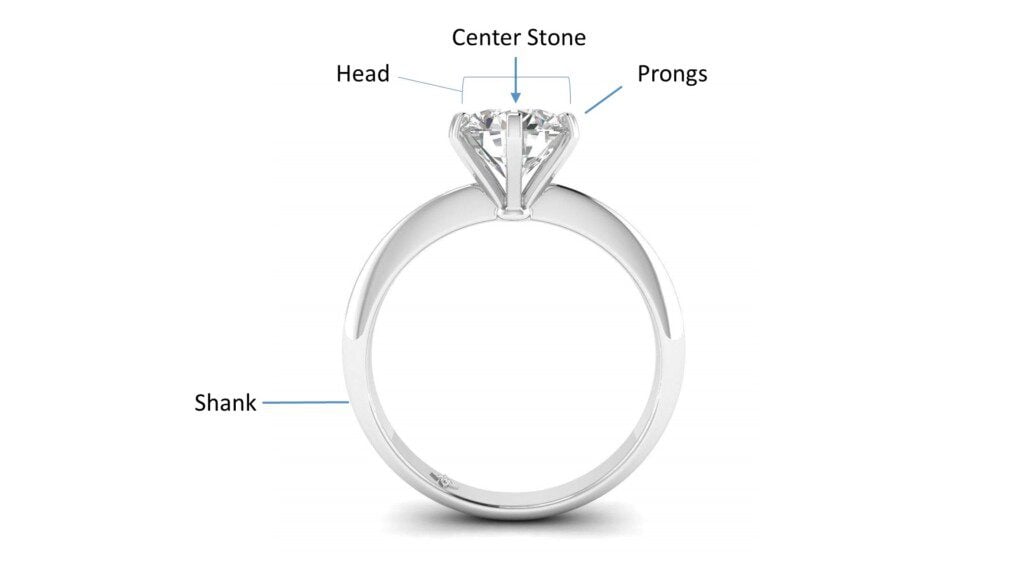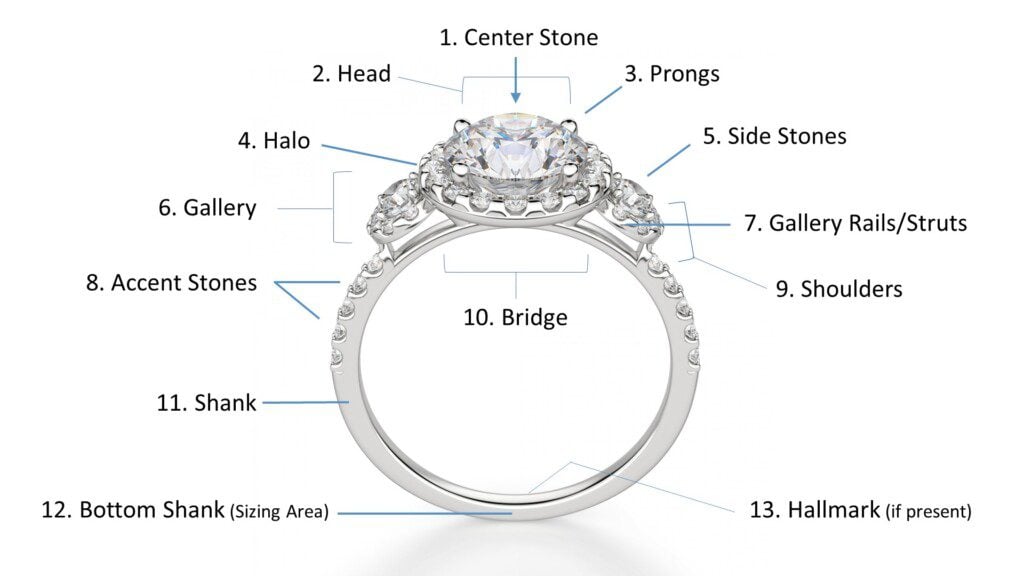How Are Diamonds Made? Natural vs Lab-Created Explained
Two Paths, One Diamond Not all diamonds come from the same place — but they all start the same way. Pure carbon, crystalized under immense pressure and heat. Whether it…
When working with a jewelry professional on diamond ring settings, especially on a custom project, it’s important to speak the same language. Bridge, Gallery, Bottom-Shank, etc.
Before going on: Check out the PriceScope Diamond Buying Guide
Wondering which of the many diamond colors is best for you? Our elite list of vetted vendors like Whiteflash and James Allen are experts at listening and helping you determine which combo of the 4Cs is perfect for you - and nicely in budget. Contact Us and get help today.
Not all diamond ring settings will have all components described below. A simple solitaire, for example, features a center-stone, secured by 4-6 prongs into a head connected to the shank.

You can explore various styles of diamond ring settings to see examples with more components, from solitaire and prong-settings to three-stone and five-stone settings, halo settings, bezel settings, split-shank settings, tension settings, pave settings and more.
PriceScope’s 1-5 star ratings are categorical comparisons with the most thorough, consumer-focused online diamond and jewelry vendors, in categories, we believe reflect our experienced consumer community’s values. Check out PriceScope Jeweler Reviews.

Think of the central gemstone as the star of the show. The rest of the setting is the stage the star will shine on. Whether you choose a simple solitaire featuring your center stone in solo performance, or an elaborate stage with side-stones, a halo or accent stones, the center stone is the main attraction of all diamond ring settings.
The top portion of the ring holding the central gemstone, and any side stones, is the head. When considering a head form follows function. It must be strong enough to resist bending while protecting and preventing the center stone from falling out in conditions of normal wear. Remember, these are not museum pieces. Most diamond ring settings get exposed to accidental knocks here and there. At the same time, a head that’s too elaborate risks covering up the diamond. Go for balance that permits the center stone to safely remain the star of the show.
The most common way of securing the center stone used in diamond settings is prongs (there are other diamond setting methods). Not only are the prongs critical to the integrity of the ring, they constitute part of the overall aesthetic. The prongs are formed by bending metal over the diamond, after which they can be shaped. There are several different visual styles: Soft claw prongs, sharp claws, rounded prongs, tab style prongs, heart prongs, etc.
A halo adds a row or rows of melee (small diamonds) on diamond settings outside the border of the center stone. This serves to make the central gemstone appear larger and adds more brightness, fire and sparkle to the head of the setting. If a halo is used the ring falls into the Halo Setting style.
Side stones are larger than accent stones. They are used to add more total carat weight and overall sparkle to the top of diamond settings. Many times side stones will be accompanied by their own laboratory grading reports. 3-Stone rings and 5-Stone rings are popular Side Stone Setting diamond ring settings examples. Side Stones can be any shape but should have comparable color and clarity to the center stone. Alternately, they may be colored gemstones of sufficient hardness, chosen to add a splash of color contrast to the setting.
The gallery is the area between the gallery-rails/struts and the bridge. On some designs this area is left unadorned and open, possibly permitting the wearer to see the center stone’s culet (the very bottom of the diamond).
PriceScope Pointer: Some jewelers advise leaving galleries open so light can enter the diamond from all sides, but this only works for poorly cut diamonds. Any well-cut diamond gathers all light from above and the bottom facets act as mirrors, so no light enters from the side.
The gallery rail, or strut, is essentially a bar that sits about midway between the top of the stone and the bridge of diamond settings to keep the prong structure secure. A gallery rail is highly recommended for diamond ring settings with only 4 prongs, for center stone security. It can be highly polished, engraved, set with tiny diamonds or embellished with milgrain for additional decoration.
“Melee” are typical accent stones, usually under 2.5 millimeters in width, added to give extra sparkle and total carat weight. They are frequently set on the shoulders and/or down the shank. They can also adorn the bridge, gallery rails and even the prongs holding the center stone.
The shoulders are the top sides of the engagement ring, frequently rising off the finger and serving to elevate and/or protect the center stone. Accent stones are frequently used on the shoulders.
The bridge rests on top of the wearer’s finger. The bridge is the part of the ring that rests on top of your finger. In some diamond ring settings the bridge will incorporate a rounded area which anchors the head to the ring. That round area is called a donut.
The shank is the band of the ring which holds it on the wearer’s finger. It may take on different shape-outlines, but the inside should have rounded edges and be comfortable to wear. The shank can be plain and highly polished, or it may be adorned with accent stones or embellishments.
The bottom shank is the portion that runs around the bottom of the wearer’s finger (on the palm side of the hand). This area is frequently thinner or wider than the rest of the shank, depending on the style and design. A wide bottom shank can stop a ring from spinning on the hand. A thin bottom shank makes the shoulders and head stand out and is more comfortable for those who’s fingers swell easily.
The bottom shank is also where jewelers will make any needed size adjustments to diamond ring settings, removing metal to size-down or adding metal to size-up. Resultantly, the bottom shank is typically left plain.
Diamond settings are hallmarked with a manufacturer’s stamp to identify metal composition. 18k and 14k indicate gold karat alloys. PT, Plat and Platinum indicate platinum alloys, often preceded or followed by a number indicating purity: 950 indicated 95% platinum alloyed with another metal – most frequently iridium, ruthenium or cobalt.
If you’re looking to buy loose diamonds online, use our special tools to reveal the best cut quality diamonds! Start your diamond search and choose from over a million loose diamonds for sale. Use our filters to find either natural or lab diamonds, as well as fancy color diamonds.
Get fast answers to any question: Ask our community of unbiased independent helpers.
Ready to find your diamond?

Retail Diamond Prices Chart Updated Monthly.

Two Paths, One Diamond Not all diamonds come from the same place — but they all start the same way. Pure carbon, crystalized under immense pressure and heat. Whether it…
A Wedding Ring as Unique as Your Love Finding the right wedding ring isn’t just about diamonds or gold – it’s about finding the one that feels right. With hundreds…
So, you’re thinking about lab-grown diamonds? Smart move. They’re just as sparkly as the natural kind but usually cost less. But where do you actually go to buy them? It…

Want to stay updated on the most recent blogs, forum posts, and educational articles? Sign up for Bling News, PriceScope’s weekly newsletter.